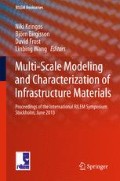Abstract
We develop in this study a coupled creep-damage model for concrete subjected to moderate temperatures. The coupling procedure relies on the concept of pseudo-strains introduced by Schapery [1], which allows to reformulate the initial viscoelastic problem as an equivalent elastic one by using a correspondence principle. The creep model is based on a micromechanical approach where a simplified representation of the material as a composite made of a linear viscoelastic matrix with distributed elastic inclusions and pores is adopted. One interesting feature is that analytical expressions for both bulk and shear moduli in the time space are derived in simpler cases when a limited number of Maxwell elements are involved to describe the matrix behavior. The well-known macroscopic isotropic damage model due to Mazars [2] is adopted to reproduce the cracking effects. The evolution of the damage variable is governed by an equivalent strain calculated from the pseudo-strains. The model is further extended to the case of moderate temperature increases with the aid of the equivalent time method. It is then applied to the simulation of concrete basic creep tests at different temperatures ranging from 20 to 80°C. The results are compared to experimental data and show a good agreement provided an adequate identification of the model parameters. The model response tends to show that the creep strains result mainly from the viscous characteristics of the material, and to a lesser extent to the damage growth. This conclusion holds for both ambient and moderate temperatures.
Access this chapter
Tax calculation will be finalised at checkout
Purchases are for personal use only
Preview
Unable to display preview. Download preview PDF.
References
Schapery, R.A.: Correspondence principles and a generalized J integral for large deformation and fracture analysis of viscoelastic media. International Journal of Fracture 25, 195–223 (1984)
Mazars, J.: A description of micro-and macroscale damage of concrete structures. Eng. Fracture Mech. 25, 729–737 (1986)
Bazant, Z.P., Chern, J.C.: Concrete creep at variable humidity: constitutive law and mechanism. Mater. Struct. 18, 1–20 (1985)
Bažant, Z.P., Xi, Y.: Drying creep of concrete: constitutive model and new experiments separating its mechanisms. Mater. Struct. 27, 3–14 (1994)
Benboudjema, F., Meftah, F., Torrenti, J.M.: Interaction between drying, shrinkage, creep and cracking phenomena in concrete. Eng. Struct. 27, 239–250 (2005)
Sellier, A., Buffo-Lacarriere, L.: Towards a simple and unified modelling of basic creep, shrinckage and drying creep of concrete. Eur. J. Environ. Civ. Eng. 13, 1161–1182 (2009)
Le, Q.V., Meftah, F., He, Q.-C., Le Pape, Y.: Creep and relaxation functions of a heterogeneous viscoelastic porous medium using the Mori-Tanaka homogenization scheme and a discrete microscopic retardation spectrum. Mech. Time-Depend Mater. 11, 309–331 (2008)
Scheiner, S., Hellmich, C.: Continuum microviscoelasticity model for aging basic creep of early-age concrete. J. Eng. Mech.-ASCE 135, 307–323 (2009)
Gu, S.-T., Bary, B., He, Q.-C., Thai, M.-Q.: Multiscale poro-creep model for cement-based materials. Int. J. Numer. Anal. Methods Geomech. (2012)
Mazzotti, C., Savoia, M.: Nonlinear creep damage model for concrete under uniaxial compression. J. Eng. Mech.-ASCE 129, 1065–1075 (2003)
Briffaut, M., Benboudjema, F., Torrenti, J.M., Nahas, G.: Numerical analysis of the thermal active restrained shrinkage ring test to study the early age behavior of massive concrete structures. Engineering Structures 33, 1390–1401 (2011)
Park, S.W., Richard Kim, Y., Schapery, R.A.: A viscoelastic continuum damage model and its application to uniaxial behavior of asphalt concrete. Mechanics of Materials 24, 241–255 (1996)
Thai, M.-Q.: Modélisation micromécanique et simulation numérique du fluage des bétons avec prise en compte de la microfissuration et des effets thermohydriques, PhD thesis, Université de Marne-La-Vallée (2012) (in French)
Bazant, Z.P., Cusatis, G., Cedolin, L.: Temperature effect on concrete creep modeled by microprestress-solidification theory. J. Eng. Mech. 130, 691–699 (2004)
Arthanari, S., Yu, C.W.: Creep of concrete under uniaxial and biaxial stresses at elevated temperatures. Mag. Concr. Res. 19, 149–156 (1967)
Parrott, L.J.: Lateral strains in hardened cement paste under short-and long-term loading. Mag. Concr. Res. 26, 198–202 (1974)
Author information
Authors and Affiliations
Editor information
Editors and Affiliations
Rights and permissions
Copyright information
© 2013 RILEM
About this paper
Cite this paper
Thai, MQ., Bary, B., He, QC. (2013). Coupled Creep and Damage Model for Concrete at Moderate Temperatures. In: Kringos, N., Birgisson, B., Frost, D., Wang, L. (eds) Multi-Scale Modeling and Characterization of Infrastructure Materials. RILEM Bookseries, vol 8. Springer, Dordrecht. https://doi.org/10.1007/978-94-007-6878-9_26
Download citation
DOI: https://doi.org/10.1007/978-94-007-6878-9_26
Publisher Name: Springer, Dordrecht
Print ISBN: 978-94-007-6877-2
Online ISBN: 978-94-007-6878-9
eBook Packages: EngineeringEngineering (R0)

